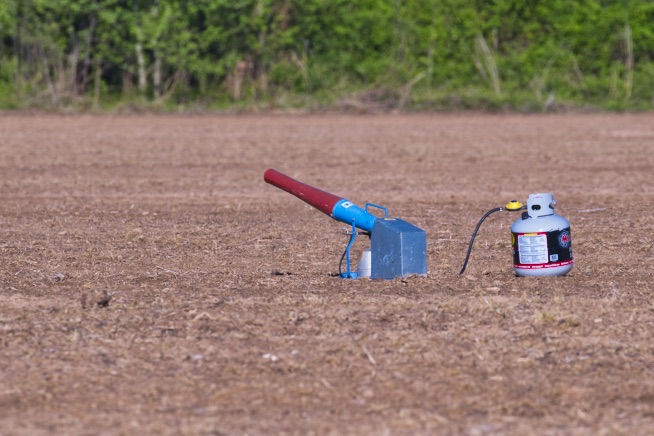Propane Cannons: An Effective Tool at Sequoyah National Wildlife Refuge
The Sequoyah National Wildlife Refuge in Oklahoma is a sanctuary for diverse plant and animal species. Among its key strategies to protect crops and maintain balance is the use of sound cannons—a humane and effective solution to deter wild hogs. Like many protected areas, it faces challenges balancing agricultural needs with wildlife conservation. A significant issue has been the damage caused by wild hogs to crops during critical growth periods. To address this, the refuge uses sound cannons—a humane and innovative solution to deter these destructive animals.
Propane cannons are strategically placed in fields to emit loud, periodic bursts of sound. These noises startle wild hogs, discouraging them from lingering in the area. This method effectively protects crops without harming the animals. While the noise temporarily disrupts other wildlife, such as deer and coyotes, the primary goal is to safeguard the crops that support the refuge’s ecosystem.

Managing Wild Hogs with Propane Cannons
Wild hogs are invasive and cause significant damage to crops, soil, and native habitats. They uproot plants, trample vegetation, and consume large quantities of crops, leaving a trail of destruction. Propane cannons provide a cost-effective and humane way to address this issue.
- How they work: The cannons produce loud sounds that mimic gunfire or explosions, scaring the hogs away.
- Advantages: Easy setup, minimal maintenance, and coverage of large areas.
- Humane approach: These devices align with conservation goals, avoiding harm to animals while addressing crop damage.
This method has proven successful for wildlife refuges and farmers aiming to balance agricultural productivity with ethical wildlife management. For more on how the refuge addresses invasive species, read Battling Invasive Feral Hogs at Sequoyah National Wildlife Refuge.
Protecting Crops and Ecosystem Health
Propane cannons are part of a broader effort to maintain the ecological balance at Sequoyah. Protecting crops benefits the entire refuge by ensuring a stable food supply for native species. Healthy crops also contribute to soil quality and biodiversity, creating a ripple effect throughout the ecosystem.
As a wildlife photographer, I’ve experienced the temporary challenges these cannons create. Loud noises can make animals like deer and coyotes more skittish, complicating photography. However, the long-term benefits of protecting the refuge’s resources far outweigh these inconveniences. With careful planning, it’s still possible to capture stunning wildlife images while respecting the refuge’s conservation efforts.
The Science Behind Propane Cannons
Propane cannons are engineered to produce sounds that trigger an animal’s natural flight response. These bursts of noise can be adjusted in frequency and timing to prevent animals from becoming desensitized. This adaptability ensures that the cannons remain effective over time.
By avoiding lethal methods, sound cannons align with modern conservation ethics. For additional information on managing feral swine populations, visit USDA Feral Swine Management. They allow coexistence between humans and wildlife, preserving biodiversity while addressing agricultural needs.
FAQs
How do sound cannons work?
They emit loud, periodic sounds that mimic alarming noises, scaring nuisance animals like wild hogs away.
Are sound cannons harmful to wildlife?
No, they are a non-lethal method of wildlife management that relies on sound to deter animals without causing harm.
Why are wild hogs a problem at the refuge?
Wild hogs damage crops, uproot plants, and disrupt soil, significantly impacting agricultural yields and the ecosystem.
Can sound cannons disrupt other wildlife?
Yes, the noise can temporarily startle animals like deer and coyotes. However, the primary purpose is to protect crops and manage wild hog populations.
Are there alternatives to sound cannons?
Other methods include fencing, traps, and repellents. However, sound cannons are often preferred for their cost-effectiveness and ability to cover large areas.
How does this impact wildlife photography?
Propane cannons may make certain animals more skittish, but planning visits during quieter times or focusing on less-affected species can still yield excellent photographs.
Looking Ahead
The use of sound cannons at Sequoyah National Wildlife Refuge demonstrates the refuge’s commitment to balancing conservation and agriculture. By adopting non-lethal, science-based methods, the refuge protects its resources while preserving its role as a sanctuary for wildlife. While they may pose temporary challenges for photographers and visitors, these efforts are essential for maintaining the refuge’s ecological health.
